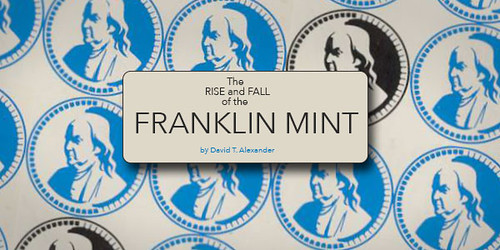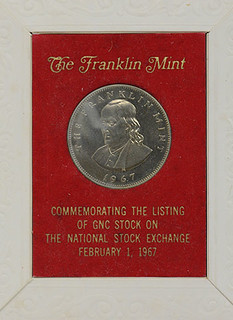
PREV ARTICLE
NEXT ARTICLE
FULL ISSUE
THE RISE AND FALL OF THE FRANKLIN MINT
On December 28, 2015 David Alexander published a nice article in CoinWeek about the history of Joe Segel's Franklin Mint. Here
are some short excerpts - be sure to read the complete version online. -Editor

Early Days
John Alexander’s research in this dynamic young company interested his employers, the stock brokerage house of Hill, Darlington and Grimm, which was active in underwriting and promoting new stock issues. FM was then only one department of a parent firm called General Numismatics Corporation (GNC), whose home town was Yeadon, Pa., not yet renamed Franklin Center. The story of the stock issue and of the beginning years of the Franklin Mint is basically the story of its founder, advertising specialties prodigy Joseph M. Segel (born 1931). Segel was a remarkable example of the go-getting American entrepreneur, who launched GNC in 1964 with an investment of $21,000. His business experience was already extensive and uniformly successful. At the age of 13, he had launched a successful printing business before entering the prestigious Wharton School of Business administration in Philadelphia, PA. Collectors who associate the name Franklin Mint with the cataracts of gleaming coins it struck and marketed for an array of governments or its many medal and ingot series are generally surprised to learn that most of its production in its founding year was base metal gaming tokens struck for 27 casinos, mostly located in Las Vegas and Reno, Nevada. Some of the research involved my driving all over Miami, FL, seeking examples of gaming tokens made by FM. During 1964, silver prices began to soar, causing copper nickel-clad copper coins to come into production at the U.S. Mints and focusing avid interest on the millions of U.S. silver dollars needed to keep the casinos going “Ka-Ching!” that were vanishing overnight. Segel watched as the clamoring public stormed the nation’s banks, eager to redeem their Silver Certificates for silver dollars from long-ignored Treasury stocks and later for silver granules from the national stockpile. Watching block-long lines form outside area banks, the young businessman was fascinated by the profits offered by coin collecting. National Commemorative Society
A couple of early management decisions set the tone for Segel’s NCS and later membership medal series. All were struck in Sterling silver, .925 fine, which founder Segel appeared to believe was the highest fineness available. Makers of traditional large-diameter, high-relief medals, generally chose .999 fine silver for their creations. NCS closed its subscriber list at only 5,249 members, issuing one 39-millimeter medal each month, which were unobtainable by frequently irritated non-members continuing to read about the series in the numismatic press. All were distinctly coin-like objects combining low relief and brilliant Proof surface. Segel called all of these low-relief pieces “coin-medals.” The term was distinctly contrived but starkly necessary. In 1965 the vast majority of collectors in the U.S. were trained to focus on and collect coins and avoid medals at all costs. Segel resorted to this hybrid term to overcome a widely held prejudice. . Gilroy Roberts
His creative opportunities were unlimited in his new post, and in these early years great honor was paid to the Franklin Mint’s artistic staff. The name Gilroy Roberts “sold,” as in “Gilroy Roberts’ Birds,” and good use was made of it in merchandizing FM and its rapidly growing range of products. Segel possessed limitless self confidence. Where others eased into competitive situations, testing the waters, he plunged right in. During the search for substitute metals for U.S. silver coinage, he was an active participant, distributing a cased three-piece set of dollar-size pieces called “Pattern Trial Proofs.” Designed by Roberts, these depicted historic Gardiner’s Island and its colony of fishing hawks or ospreys, located near the eastern tip of Long Island, N.Y. Fantasy Coins and Real Inaugural Medals
SMOM is the actual military and charitable Order established in the Holy Land after the First Crusade in the 12th century. The Order was later based on the island of Rhodes and subsequently on Malta until 1798. Since the early 19th century it had its headquarters on the Bocca de Leone in Rome and is a recognized sovereign entity enjoying diplomatic relations with some 30 countries. The Franklin Mint’s group was based in remote Shickshinny, Pa., and had no relation to the historic order in Rome. Segel’s relentless pursuit of the main chance was brilliantly exemplified in his successful bid for the contract to strike and distribute the 1973 Richard M. Nixon-Spiro T. Agnew Inaugural Medal. The late medal historian Neil MacNeil in his award-winning book, The President’s Medal described the Franklin Mint as “aggressive and almost startlingly active.” First donating $113,000 in Franklin Mint stock to the re-election committee, Segel closed in to clinch the medal deal. Outgunning the staid and traditional Medallic Art Company, he had already prepared dies for five different portraits and struck bronze and silver medals from them to display to the overwhelmed Inaugural Committee. Medallic Art thought it could guarantee $750,000 in overall sale of medals and then then-popular collector plates. Segel guaranteed $1 million and promptly whipped out a bank check for that amount, payable immediately. Not surprisingly, Franklin Mint and Gilroy Roberts produced the Nixon-Agnew Medal. It was marketed vigorously in both Proof and antique finishes in silver and bronze, bronze goldplate along with a dazzling Inaugural Plate with the same conjoined heads. Artistic criticism of its low relief and uninspired design went unheard as this medal was a dramatic financial success. To read the complete article, see:

Wayne Homren, Editor The Numismatic Bibliomania Society is a non-profit organization promoting numismatic literature. See our web site at coinbooks.org. To submit items for publication in The E-Sylum, write to the Editor at this address: whomren@gmail.com To subscribe go to: https://my.binhost.com/lists/listinfo/esylum All Rights Reserved. NBS Home Page Contact the NBS webmaster 
|
